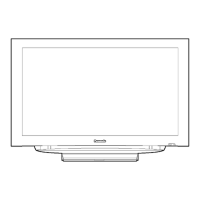MPU SOS Inputs and Blink Codes
MPU SOS Inputs and Blink Codes
30
One Blink: One blink of the power LED indicates a problem in the inverter circuit located on the LCD panel. The inverter
board is not to be repaired in the field. Therefore a replacement is required.
Three Blinks: Three blinks of the power LED indicates an over-current or over-voltage condition in one of the DC supplies
of the AP board. The AP board is repairable. Therefore the use of an ohmmeter and peak-hold-voltmeter is required to
determine the cause of the shutdown. An over-voltage condition is definitely a defect of the AP board. An over-current
condition may be due to a short circuit located in the AP board, A board, or the LCD panel.
Five, Seven, or Eight Blinks: The A board is responsible for five, seven or eight blinks of the power LED. The MAIN +3.3V,
MAIN +5V, and MAIN +9V sources are all produced on the A board. The detection input pins of the MPU, IC1100, monitor
for their presence.
Four or Six Blinks: The AP board is responsible for four or six blinks of the power LED. The DTV9V, and SUB_5V
sources are produced on the AP board. The MPU IC1100 monitors for their presence when the unit is connected to AC
Power. A short or open circuit on the A board may also be responsible for their absence.
Nine Blinks: Nine blinks of the power LED is due a short circuit in the audio output circuit (s) of the unit. The audio output
circuit is located on the A board. Confirm the status of the speakers. If defective, perform a replacement. If ok, replace the A
board.
Ten Blinks: Ten blinks of the power LED indicates a malfunction of IC4200, the frame converter. This IC resides on the A
board. Therefore ten blinks of the power LED requires the replacement of the A board.

